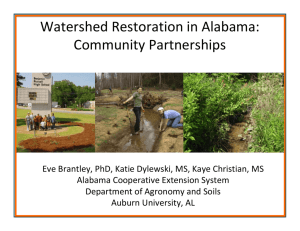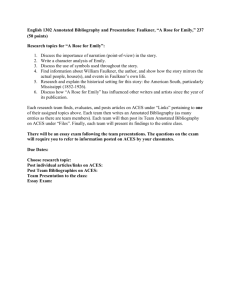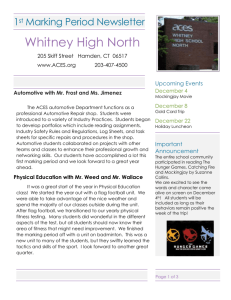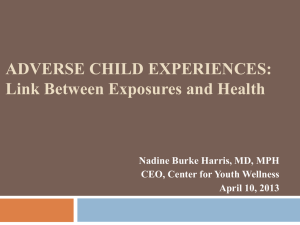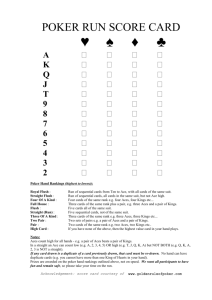How To Write a Paper for Publication In a Journal
advertisement
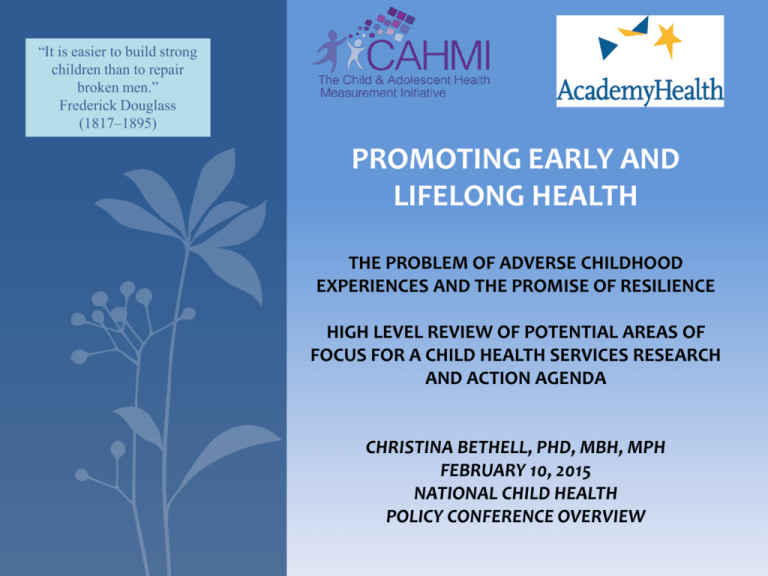
“It is easier to build strong children than to repair broken men.” Frederick Douglass (1817–1895) PROMOTING EARLY AND LIFELONG HEALTH THE PROBLEM OF ADVERSE CHILDHOOD EXPERIENCES AND THE PROMISE OF RESILIENCE HIGH LEVEL REVIEW OF POTENTIAL AREAS OF FOCUS FOR A CHILD HEALTH SERVICES RESEARCH AND ACTION AGENDA CHRISTINA BETHELL, PHD, MBH, MPH FEBRUARY 10, 2015 NATIONAL CHILD HEALTH POLICY CONFERENCE OVERVIEW National and State Data on Adverse Childhood Experiences and Resilience FOR CHILDREN (2011-12 NSCH (HRSA/MCHB/CDC) 47.9% of US Children 1+ (of 9) ACEs Age 0-17 years WA MT OR ME ND MN ID WY WI SD NE NV 22.6 25.3 CA No adverse family experiences UT AZ 52.1 CO IA PA IL KS OK NM MI MO WV KY TX AR DC SC GA LA HI Two or more adverse family experiences VA NC TN MS AL One adverse family experience NJ MD DE ! OH IN VTNH NY MA CTRI FL AK State Ranking Lower=Better Performance Significantly lower than U.S. Lower than U.S. but not significant Higher than U.S. but not significant Significantly higher than U.S. Statistical significance: p<.05 State Variation In Prevalence of 2+ (of 9) ACES 16.3% (UT) – 32.9% (OK) across states. 5/13/13 Christina Bethell, PhD, MPH. ACES & Resilience CAHMI AH Project Overview 2 Adverse Child Experiences: NSCH National Prevalence State Range Child had one or more Adverse Child or Family Experiences 47.9% 40.6% (CT) - 57.5% (AZ) Child had two or more Adverse Child or Family Experiences 22.6% 16.3% (NJ) - 32.9% (OK) Extreme economic hardship 25.7% 20.1% MD – 34.3% (AZ) Divorce/separation of parent 20.1% 15.2% (DC) – 29.5 (OK) Death of parent 3.1% 1.4% (CT) – 7.1% (DC) Parent served time in jail 6.9% 3.2% (NJ) – 13.2% (KY) Witness to domestic violence 7.3% 5.0% (CT) – 11.1% (OK) Victim or witness of neighborhood violence 8.6% 5.2% (NJ) – 16.6% (DC) Lived with someone who was mentally ill or suicidal 8.6% 5.4% (CA) – 14.1% (MT) Lived with someone with alcohol/drug problem 10.7% 6.4% (NY) – 18.5% (MT) Treated or judged unfairly due to race/ethnicity 3 4.1% 1.8% (VT) – 6.5% (AZ) Adverse Childhood Experiences Christina Bethell, PhD, MPH. ACES & Resilience CAHMI AH Project Overview 4 Project Background Core Leadership and Coordinating Team: CAHMI: Christina Bethell; Michele Solloway; Dave Ford; Caitlin Murphy (others) AcademyHealth: Lisa Simpson; Aditi Srivastav (others) CAHMI Strategy (since 1997) Family-Centered, Data Driven Partnerships to Promote Early and Lifelong Health Transformative Goals For Child Health Promote Child Health and System Excellence Transformational Partnerships Actionable Data & Data-Driven Tools Inspire and Inform 7 AcademyHealth AcademyHealth is a leading national organization serving the fields of health services and policy research and the professionals who produce and use this important work. Together with our members, we offer programs and services that support the development and use of rigorous, relevant and timely evidence to: 1. Increase the quality, accessibility and value of health care, 2. Reduce disparities, and 3. Improve health. A trusted broker of information, AcademyHealth brings stakeholders together to address the current and future needs of an evolving health system, inform health policy, and translate evidence into action. Christina Bethell, PhD, MPH. ACES & Resilience CAHMI AH Project Overview 8 CAHMI and AcademyHealth Partnership (with you!) • Focus: • Transforming the roles of health providers and health systems to identify, prevent and address ACEs in their communities and promote healing and positive health attributes that may buffer, prevent and attenuate the intergenerational cycle of ACEs. • Partnership activities will result in: • an agenda on research and policy priorities to address ACEs • communications infrastructure • Special journal issue APHA and set of field building/advancing articles • Materials to engage the field in continued development, collaboration and collective action • Funding: CAHMI and Robert Wood Johnson Foundation Christina Bethell, PhD, MPH. ACES & Resilience CAHMI AH Project Overview 9 Project Scope • The project will focus at three levels on this issue: • The clinician/family level • The healthcare organization level, including hospitals, clinics, and health plans. • The health policy level • For each level, we are asking: • What do we know about ACEs and promoting child development and well-being. • What do we know about how ACEs are currently addressed? • What evidence exists? • What research questions are of highest priority to address? • What actions can be taken at each level? Christina Bethell, PhD, MPH. ACES & Resilience CAHMI AH Project Overview 10 Broader CAHMI Focus and Partnerships Christina Bethell, PhD, MPH. ACES & Resilience CAHMI AH Project Overview 11 Achieving a WHOLE Population Effect Data Collection and Analysis Adjustments and Spread to Scale & Public Acceptance Research, Interpretation And Dissemination Training, dialogue, tools, techniques 1. Population Effect Field Trial Evaluation And Learning Field Trials: Trauma Informed Communities and Care Tools, Trainings, Curriculum Consulting, Strategy, Collective Impact Our Audacious Yet Humble Aspirations We would judge the overall nine month (now 24 months) project coled by CAHMI and AcademyHealth to be successful if one or more of the following is accomplished: • A prioritized child health services research and policy agenda is widely distributed to key stakeholders and funders; • A set of field advancing/research papers published and widely distributed • The agenda and communications materials are distributed to key actors who use them in their advocacy/action strategies; and/or • New connections are formed between essential actors in this country and internationally that advance a collective impact around childhood trauma prevention & healing and family well-being. Christina Bethell, PhD, MPH. ACES & Resilience CAHMI AH Project Overview 13 Addressing key health services & policy research domains for each key action area and priority populations and possibilities (pre-meeting input) Critical HSR/P Area Emerging from PreMeeting Co-Digital Input and Dialogue Design and develop new research and knowledge Translate and integrate existing knowledge 1. Organization & financing of health systems and services 2. Access & coordination of services & resources 3. Practitioner & family engagement, communication & behavior 4. Measurement, informatics & clinical decision making 5. Health professions work force capacity, training & support Problems Possibilities Priority questions Priority Populations Existing and Promising Practices Existing and Potential Partnerships 6.Clinical evaluation & outcomes research Christina Bethell, PhD, MPH. ACES & Resilience CAHMI AH Project Overview 14 Emerging Scope of Agenda Organization and financing of health systems and services Health professions work force capacity, training and support Access & coordination and services and resources Six Fundamental Health Services and Policy Research Domains Practitioner & family engagement, communication & behavior Clinical evaluation and outcomes research Measurement, informatics and clinical decision making Christina Bethell, PhD, MPH. ACES & Resilience CAHMI AH Project Overview 15 Agenda and Communications Process and Methods Discovery phase Synthesis phase Dissemination phase Christina Bethell, PhD, MPH. ACES & Resilience CAHMI AH Project Overview 16 Steps for Building an Agenda 1) Review goals, strategies and/or priorities and conduct a research needs assessment. 2) Review existing supporting research and identify gaps in current available research (or gaps in awareness of gaps). 3) Determine additional research needed and assess funding innovations and resourced options and research resources/skills capacity. 4) Prioritize existing and additional research based on criteria. 5) Align research to goals, strategies, priorities, and add effectiveness indicators. 6) Link research to other plans and initiatives. 7) Establish timeline and trajectories envisioned for research and action 8) Share with the broader constituency groups for feedback and information sharing. 9) Adjust research agenda accordingly based on feedback. 10) Promote and foster implementation of the research agenda, and conduct ongoing review research and reevaluate research agenda. Christina Bethell, PhD, MPH. ACES & Resilience CAHMI AH Project Overview 17 Discovery: Process and Methods March-June 2014: Convene starting working group and specify goals and priorities for summit meeting and agenda March-June ‘14 and Ongoing: Conduct an environmental scan of research and initiatives June 5-6, 2014: Convene early stage partners to review and further specify goals, priorities and to strengthen relationships, collaboration and facilitate shared vision Christina Bethell, PhD, MPH. ACES & Resilience CAHMI AH Project Overview 18 Synthesis: Process and Methods July-September ‘14: Convene working group to • agree on core summit meeting summary and core themes and components for emerging research agenda • identify topics and focus for a series of papers to commission and publish on what is known and recommendations for research and action. • further refine the environmental scan and project niche October-December ‘14: Invite and gain agreement from identified candidate paper author leads. March ‘14-ongoing: propose and procure additional funding to ensure full funds available to commission all envisioned papers and public special journal issue 5/13/13 Christina Bethell, PhD, MPH. ACES & Resilience CAHMI AH Project Overview 19 Synthesis: Process and Methods January-March ‘14: Launch start of commissioned papers (to be completed Summer, 2015) April-December ‘14: Research and write baseline paper on ACEs in children in the US (Health Affairs, December ‘14) July-November ‘14: Assess capacity of NSCH to produce local reports on ACEs and develop for key ACEs summit meetings focused on counties/cities. July ‘14-January ‘15: Develop short video based on June meeting; Develop a basic web presence to communicate about the project and continue to update and convene working groups as possible and needed. Christina Bethell, PhD, MPH. ACES & Resilience CAHMI AH Project Overview 20 Dissemination: Process and Methods September-ongoing: Submit abstracts and proposals to report on and further evolve a collective action approach to advancing the promotion of early and lifelong health through an effective approach to ACEs. October-February 2014: Plan for and conduct a special panel at National Child Health Policy Conference in DC—early review and dialogue on agenda February-December 2015: Publish papers; complete version 1.0 of agenda; complete “Champions Toolkit”; evolve project; disseminate; Christina Bethell, PhD, MPH. ACES & Resilience CAHMI AH Project Overview 21 Agenda Setting Input and Status CO-Digital Collective Insight Questions Question 1: What should the specific goals of our community be related to ACEs and resilience? (e.g. the child health services research and policy community. Question 2: What research and policy domains and questions are highest priority. Questions 3: What are the research questions, policy actions and existing efforts to consider as priorities in an agenda. Christina Bethell, PhD, MPH. ACES & Resilience CAHMI AH Project Overview 23 Emerging Agenda Components Three interlocking components comprise the emerging research and action agenda as outlined below. • Component #1: Functions and Types of Research • Component #2: Priority Topics and Focal Areas • Component #3: Short Term Collaborative Actions Christina Bethell, PhD, MPH. ACES & Resilience CAHMI AH Project Overview 24 5/13/13 Christina Bethell, PhD, MPH. ACES & Resilience CAHMI AH Project Overview 25 Top 3 Ideas: What Should the Goals Be? Christina Bethell, PhD, MPH. ACES & Resilience CAHMI AH Project Overview 26 Christina Bethell, PhD, MPH. ACES & Resilience CAHMI AH Project Overview 27 Top 3 Ides: What are priority domains and questions Christina Bethell, PhD, MPH. ACES & Resilience CAHMI AH Project Overview 28 Christina Bethell, PhD, MPH. ACES & Resilience CAHMI AH Project Overview 29 Top 3 Ideas: Existing Efforts and Knowledge to Build On Christina Bethell, PhD, MPH. ACES & Resilience CAHMI AH Project Overview 30 Component #1: Functions and Types of Research Design & Develop: synthesize existing knowledge and design and develop new translational knowledge, methods, and tools Implement & Evaluate: adapt, implement, and evaluate existing and emerging strategies to prevent and buffer impact of ACEs to promote well-being Educate & Communicate: assess existing awareness and contribute to public, provider and stakeholder education and awareness, knowledge and action. Disseminate & Support: develop methods and capacity to scale, spread and support effective prevention, intervention, and training models in the field 5/13/13 Christina Bethell, PhD, MPH. ACES & Resilience CAHMI AH Project Overview 31 Component #2: Priority Topics and Focal Areas Meanings and Measures: Advance standardization of definitions, measures, and data Core Science: Promote research to address gaps in science especially pertinent to policy and practice Public Health: Understand public health impact and opportunities for translation of knowledge into public health practice Communities: Know what a healthy community is and how to address ACEs through community based collaborations and efforts Economics: Define and measure economic impact of ACEs and return on investment through effectively addressing ACEs 5/13/13 Christina Bethell, PhD, MPH. ACES & Resilience CAHMI AH Project Overview 32 Component #3: Short Term Collaborative Actions Move the Game Board: Define a conceptual map and model to clarify definitions and foster shits in mindset and norms to facilitate collective action Continuous Translation and Improvement: Synthesis, dissemination, translation, and ongoing assessment of existing models, methods, and practices Training and Capacity Building: Provider, community, and family education and training Policy platform and demonstration: Define recommendations to align health reform and systems design with needs and health improvement opportunities 5/13/13 Christina Bethell, PhD, MPH. ACES & Resilience CAHMI AH Project Overview 33 Possible Questions to Consider What should be the goals of the child health policy community be related to ACEs and resilience and positive health development? What research questions, program and policy actions and current programs should be considered as priorities in an agenda? Why is now a good time for a broader focus on ACES in health policy? Christina Bethell, PhD, MPH. ACES & Resilience CAHMI AH Project Overview 34 (OR) Possible Questions to Consider Why is now a good time for a broader focus on ACES in child health policy? What will it take for the child health policy community and health care system to respond to ACES? What do health policymakers, program leaders and the public need to know about ACES? What are the most significant barriers to an improved policy response to ACES? If there is one thing you could change in health policy to make progress on ACES, what would it be? Christina Bethell, PhD, MPH. ACES & Resilience CAHMI AH Project Overview 35 Partnering and Participation Visit the AMCHP CAHMI DRC booth #6 and poster #PA5 (Sunday PM and Monday AM) www.cahmi.org (select adverse childhood experiences under “projects”) www.academyhealth.org/ACES info@cahmi.org msolloway@cahmi.org aditi.srivastav@academyhealth.org 5/13/13 Christina Bethell, PhD, MPH. ACES & Resilience CAHMI AH Project Overview 36 There is no greater agony than bearing an untold story inside you Maya Angelou 5/13/13 Christina Bethell, PhD, MPH. ACES & Resilience CAHMI AH Project Overview 37
